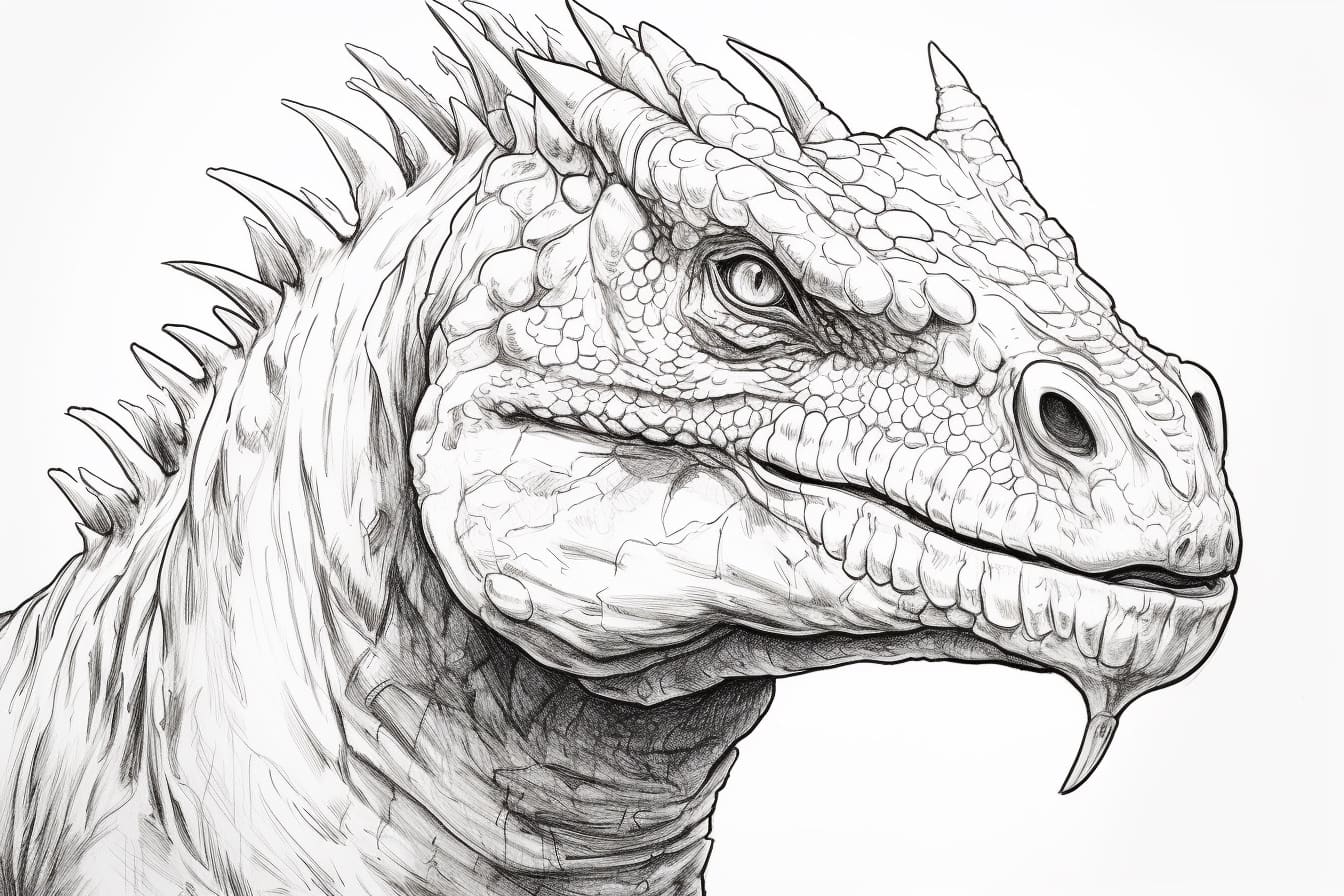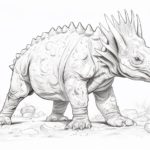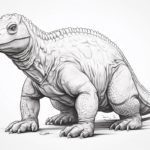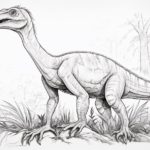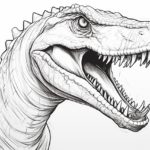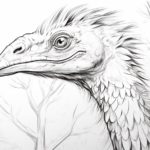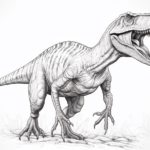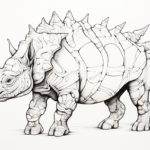Welcome to the fascinating world of drawing, where we can bring extinct creatures back to life on paper! Today, we will delve into the prehistoric era and explore the magnificent Pachycephalosaurus, known for its dome-shaped skull and powerful head-butting abilities. As we embark on this artistic journey, we will uncover the unique features of this dinosaur and learn how to capture its essence through intricate lines and shading techniques. So grab your pencils and let’s transport ourselves millions of years back in time to sketch the formidable Pachycephalosaurus!
Materials Required
To draw a Pachycephalosaurus, you will need the following materials:
- Drawing paper or sketchbook
- Pencil for sketching and outlining
- Eraser for correcting mistakes
- Colored pencils, markers, or crayons for adding color (optional)
- Reference images of a Pachycephalosaurus for accuracy and inspiration
These materials will help you create a detailed and accurate drawing of a Pachycephalosaurus.
How to Draw a Pachycephalosaurus: a Step-by-step Guide
Step 1: Gather Your Materials
Before you begin drawing a Pachycephalosaurus, make sure you have the following materials ready:
- Pencil
- Drawing paper
- Eraser
- Ruler (optional for measuring proportions)
- Reference images of a Pachycephalosaurus
Step 2: Start with Basic Shapes
- Begin by lightly sketching an oval shape for the body of the Pachycephalosaurus.
- Add a smaller oval at one end of the first oval for the head.
- Draw a curved line connecting the head to the body to outline the neck.
Step 3: Add Details to the Head
- Sketch a large, dome-shaped head on top of the smaller oval to represent the characteristic thick skull of the Pachycephalosaurus.
- Add a small, pointed snout at the front of the head.
- Draw a small eye near the top of the head.
Step 4: Draw the Limbs and Tail
- Extend two lines down from the body to represent the front legs of the dinosaur.
- Add smaller ovals at the end of the lines for the hands with three fingers each.
- Draw the hind legs by extending two lines from the back of the body.
- Add ovals at the end of these lines for the feet with three toes each.
- Sketch a long, thin tail extending from the back of the body.
Step 5: Refine the Shape and Features
- Use your reference images to add details like scales or skin texture to the body of the dinosaur.
- Refine the shape of the head and add any additional features like horns or spikes if desired.
- Add more definition to the limbs by adding muscles and joints.
- Erase any unnecessary guidelines and refine the outlines of your drawing.
Step 6: Add Shading and Details
- Decide on the light source in your drawing to determine where the shadows fall.
- Use your pencil to add shading to give the Pachycephalosaurus a three-dimensional appearance.
- Add details like wrinkles, texture, or patterns to make your drawing more realistic.
- Take your time with this step to ensure your drawing looks polished and complete.
Step 7: Final Touches
- Take a step back and assess your drawing to see if any adjustments are needed.
- Add any final touches or details to enhance the overall look of your Pachycephalosaurus drawing.
- Sign your artwork and consider sharing it with others or incorporating it into a larger art project.
Step 8: Practice and Experiment
Drawing a Pachycephalosaurus may take practice, so don’t be discouraged if your first attempt doesn’t turn out as expected. Keep practicing and experimenting with different techniques to improve your skills and create more realistic and detailed dinosaur drawings.
Conclusion
In conclusion, drawing a Pachycephalosaurus can be a fun and rewarding experience for artists of all skill levels. By following the step-by-step instructions and practicing regularly, you can create a detailed and accurate representation of this fascinating dinosaur. Remember to pay attention to the dinosaur’s unique features, such as its thick skull and long tail, and use shading and detailing techniques to bring your drawing to life. With patience and dedication, you can master the art of drawing a Pachycephalosaurus and expand your artistic abilities.
Fun Facts About Pachycephalosauruses
- Pachycephalosaurs are known for their distinctive thick, dome-shaped skulls, which could be up to 10 inches thick in some species.
- Despite their thick skulls, pachycephalosaurs were not believed to use them for head-butting like popularly depicted in movies and media. Instead, they likely used them for display, species recognition, or mating rituals.
- Pachycephalosaurs were herbivorous dinosaurs, feeding on plants and vegetation during the Late Cretaceous period.
- Some pachycephalosaur species had bony knobs or spikes on their skulls in addition to the thick dome, adding to their unique appearance.
- Pachycephalosaurs were bipedal dinosaurs, walking and running on two legs, with their long tails serving as counterbalances.
- Fossil evidence suggests that pachycephalosaurs may have lived in herds or groups, exhibiting social behavior similar to modern-day animals.
- Pachycephalosaurs were relatively small dinosaurs, with most species ranging from 6 to 16 feet in length and weighing between 100 to 450 pounds.
- The name “Pachycephalosaurus” means “thick-headed lizard” in Greek, accurately describing the prominent feature of this dinosaur.
- Pachycephalosaurs are believed to have been relatively agile and quick-moving dinosaurs, able to navigate through their environments with ease.
- The discovery of pachycephalosaur fossils has helped scientists better understand the diversity and adaptations of herbivorous dinosaurs during the Late Cretaceous period.
Suggestions for Scenes and Settings for Pachycephalosaurus Drawings
Of course! Here are some specific suggestions for scenes and settings to inspire your drawings of Pachycephalosaurus:
- Prehistoric Forest: Draw a lush, dense forest filled with ancient trees and plants, with a Pachycephalosaurus peeking out from behind a tree trunk.
- Riverside Scene: Illustrate a peaceful riverbank with a Pachycephalosaurus drinking water from the river, surrounded by colorful flowers and butterflies.
- Nesting Grounds: Show a group of Pachycephalosaurus caring for their eggs in a rocky nesting ground, with the adults watching over the hatchlings.
- Mountain Landscape: Capture the majestic beauty of a mountainous terrain with a Pachycephalosaurus standing proudly on a rocky cliff, overlooking the valley below.
- Dusk Setting: Create a serene evening scene with the sun setting in the background, casting a warm glow on a group of Pachycephalosaurus peacefully grazing in a meadow.
- Volcanic Landscape: Imagine a dramatic setting with an active volcano in the distance, as a Pachycephalosaurus navigates through the rugged terrain of volcanic rocks and ash.
- Desert Oasis: Depict a tranquil oasis in the desert, where a Pachycephalosaurus seeks refuge under a palm tree, with a shimmering pool of water nearby.
- Ice Age Scene: Transport your drawing back to the Ice Age, showing a Pachycephalosaurus braving the cold winds and icy landscape, surrounded by woolly mammoths and sabertooth tigers.
- Underwater World: Explore a fantastical underwater world where Pachycephalosaurus swims gracefully among colorful coral reefs and sea creatures.
- Alien Planet: Let your imagination run wild and create a futuristic setting on an alien planet, where Pachycephalosaurus roams under a sky filled with multiple moons and strange, otherworldly plants.
I hope these ideas inspire you to create incredible and captivating drawings of Pachycephalosaurus in various settings and scenes!

